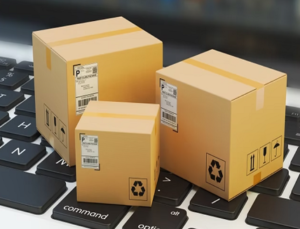
By 2023, B2B e-commerce is expected to account for 17% of all B2B sales in the United States, with a market value of $1.8 trillion. Mobile eCommerce statistics has also increased a lot with the rapid usage of mobile phones. As a result of Amazon and other successful B2B vendors, eCommerce for distributors are under tremendous pressure to transform their business models and deliver B2C-like e-commerce experiences that surpass client expectations.
Understanding of eCommerce for distributors
Shoppers are more inclined to do product research using search engines and social media. In a perfect world, customers would place orders online without speaking to a sales representative. In fact, mobile eCommerce statistics show that eCommerce is slowly overtaking the more traditional in-person retail shopping. According to a study, modern business-to-business clients conduct an average of 12 web searches before purchasing a particular organization.
This blog post will aid you in identifying critical issues and techniques for growing your B2B business and avoiding falling behind your competitors as they move to e-commerce.
What are some of the advantages of e-commerce for distributors?
B2B commerce is undergoing significant transformation. Despite being significantly impacted by consumer behavior and expectations, the business-to-consumer (B2C) industry is expected to achieve a gross merchandise value of $6.7 trillion by the end of 2020. There are no restrictions on what you can do.
Millennials currently account for 73% of B2B purchasers, which is astonishing. 44% of millennials are involved in purchasing decisions, and 33% identify as key influencers or recommenders. 60% of millennials are loyal to businesses that provide unique shopping experiences.
What does this have to do with anything at all? Millennials want the same level of service in business-to-business transactions as they do in consumer-to-business interactions. Because they are tech-savvy digital natives, they are uninterested in demanding demos, meetings, or sales calls. Individuals must have quick and easy access to information about the products they are considering purchasing.
Distributors have a lot of room to grow as a result of e-commerce. Further, B2B distributors have a unique opportunity to grow outside of usual sales channels due to their enormous pool of possible clients and simple acquisition strategy. 41% of B2B buyers demand self-service, and distributors may benefit financially as a consequence.
Distributors encounter several obstacles
Despite much data supporting the wholesale shift to online, several distributors have failed to meet customer expectations for digital shopping experiences. What is obstructing their progress?
Difficulties associated with business-to-business (B2B) transactions
Due to the complexity and diversity of their client base, B2B firms cannot use e-commerce. Several of the most often stated difficulties include the following:
- Discussing contract pricing.
- Customers are subject to their own rules and restrictions.
- Limited-edition merchandise.
- Payment and delivery options are extensive.
This is a list of issues to discuss with your e-commerce technology supplier, but they should not be considered as roadblocks to your business’s transition. With the right e-commerce platform, you can easily overcome these obstacles.
Purchases made within the organization
While it is true that B2B customers have consumerized expectations, they do not shop in the same way that B2C shoppers do.
Credit card numbers and PayPal accounts are insufficient for B2B purchases. If I were a corporate buyer, I would not make a four-hundred-thousand-dollar credit card transaction. Payments made by ACH, or “echeck,” have gained in popularity in recent years. Most businesses are looking for ach processing company or ach processing service providers for the safe B2B transactions.
B2B sellers face a variety of technical obstacles, including the following:
- Punchout solutions that integrate with the buyer’s procurement application or enterprise. resource planning systems are highly sought after.
- Payment requests are made through purchase orders.
- Your managers must authorize orders placed with you.
Is it possible for an e-commerce platform to handle all of these scenarios? That is precisely what I am attempting to convey. In a nutshell, it is platform- and integration-dependent. Businesses that cater to both B2B and B2C customers may leverage the BigCommerce platform to generate separate pricing lists or catalogs for each customer segment.
What distributors may gain from e-commerce adoption
Invariably, the potential benefits of an e-commerce channel outweigh the drawbacks mentioned above. Distributors and wholesalers may leverage e-commerce to grow their operations.
There is considerable potential for expansion and growth
Historically, distributors employed various strategies, including trade shows, advertisements in trade publications, and on-the-ground salespeople. With just a few clicks, you can reach a global audience, making it easier than ever to develop your business.
Enhanced productivity
The e-commerce platform may appear to be a drain on your resources and significantly increase your maintenance costs. Automating your activities, on the other hand, will save you time and money.
Once your e-commerce platform is operational, you may employ digital technologies such as analytics and inventory monitoring to make more informed supply chain choices. As your processes grow more efficient, it’s a win-win situation for your clients and your business. In other words, individuals can labor less and earn more via the use of digital technology. BigCommerce organizations would concur, owing to built-in e-commerce Analytics and Insights reporting.
Consider these e-commerce requirements for distributors
Individual client pricing is available
When it comes to pricing, distributors must plan. Price models may be challenging to employ when you need to customize prices to a specific customer’s level. Distributors demand an e-commerce platform that supports their digital commerce strategy, taking into account the fact that certain commodities are only accessible in certain locations or to specific customers and that shipping costs and options vary by region.
You may alter your price based on a customer’s contract or previous purchases with the appropriate technologies. The video below shows how Toolstop uses BigCommerce to divide its pricing for different consumer categories.
Additionally, there are more sophisticated search options accessible
Product discovery is challenging in the modern-day, as wholesalers generally have hundreds of SKUs. Customers expect a sophisticated and user-friendly search engine on every online e-commerce site, and distributors are powerless to refuse. Their e-commerce strategy’s success is entirely contingent on the user experience.
Customers will be happier and more engaged if advanced search tools such as faceted search are available. Make sure that a distributor e-commerce platform’s search functionality is at the top of your list of requirements.
Applying restrictions account-by-account
An account-level limitation is another necessity for a B2B e-commerce platform. As a vendor to a business, you will undoubtedly interact with various stakeholders, departments, and even locations. In other words, several people within the same organization will have access to the same data.
In summary
Business-to-business (B2B) trade continues to grow at a breakneck speed. For merchants, it creates a new and successful sales channel through which they can acquire new consumers and improve the service they now provide.
Diversifying your business may have certain advantages, but they are outweighed by the danger of falling behind and failing to meet changing customer expectations. Consider an e-commerce solution if you plan to expand your distribution business in the long run.


















